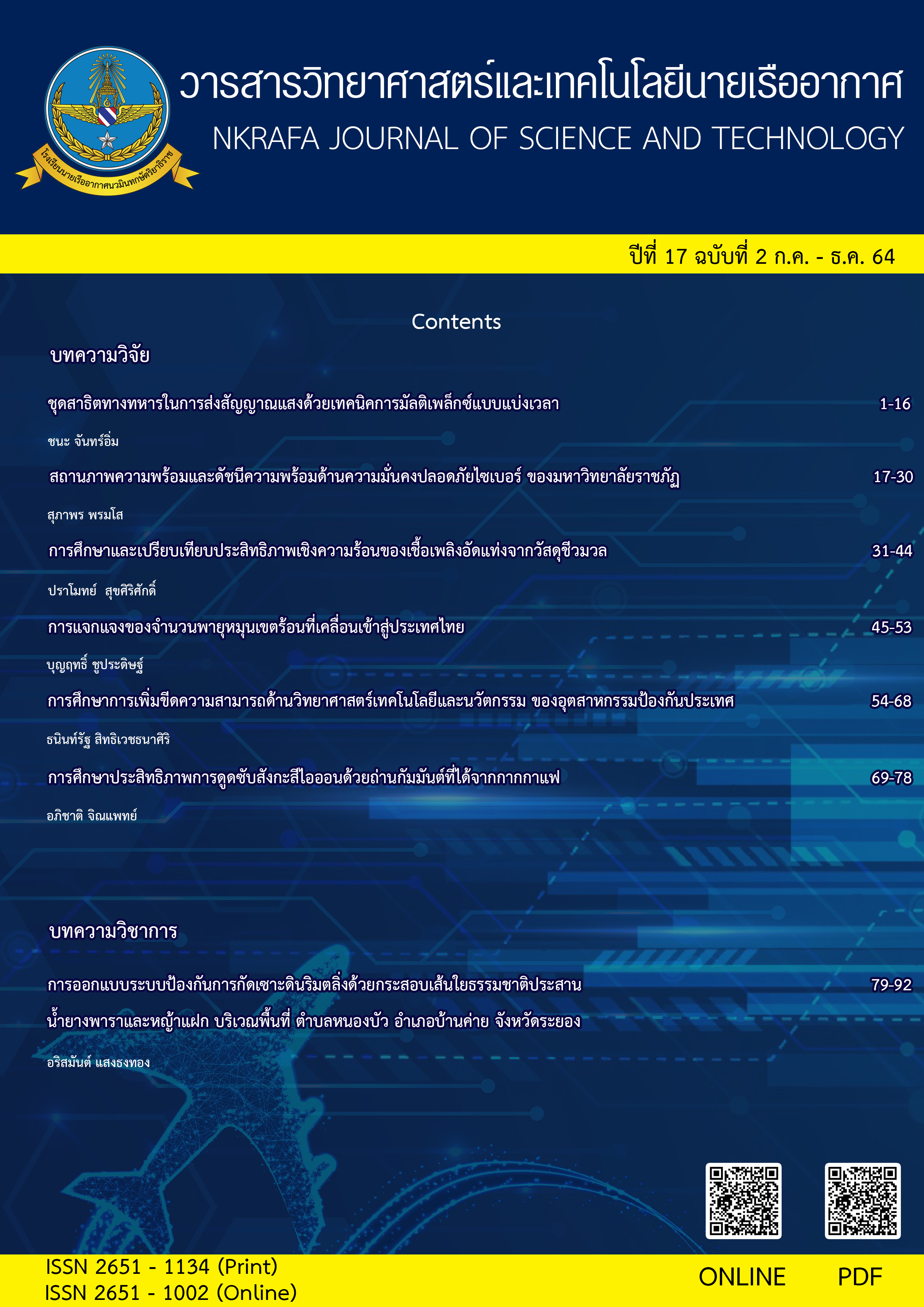Study and Comparison of Thermal Efficiency of Briquettes Fuel from Biomass Materials
Main Article Content
Abstract
Nowadays, the world has a lot of waste, both recyclable and non-recyclable materials. The type of waste that can be reused most commonly found in community sources is biomass material. Biomass materials could be used to make fuel pellets. The objective of this research was studying the heating rate of 4 types of biomass materials: tea residue, corncob, pine leaves, and bagasse paper. By using two types of binder which were paraffin and tapioca starch. Our biomass was formed into 3 shape of briquette including triangle, square, and circle. The heating efficiency of each type of the biomass briquette was compared to charcoal as the base reformed. The results showed that the briquette from square bagasse paper with paraffin as a binder at a ratio of 1:1 yielded a colorific value of 6,942.67 calories per gram. The heating efficiency of the bagasse paper briquet is 97.1% when comparing with charcoal.
Article Details

This work is licensed under a Creative Commons Attribution-NonCommercial-NoDerivatives 4.0 International License.
- Content and information in articles published in NKRAFA Journal of Science and Technology are comment and responsibility of authors of articles directly. Journal editorial do no need to agree or share any responsibility.
- NKRAFA Journal of Science and Technology Articles holds the copyright of the content, pictures, images etc. which published in it. If any person or agency require to reuse all or some part of articles, the permission must be obtained from the NKRAFA Journal of Science and Technology.
References
Information on. สถานการณ์ขยะในไทย. สืบค้น 10 มิถุนายน2564, https://www.bangkokbiznews. com/ news/detail/863554.
Information on. สรุปสถานการณ์พลังงานปี 2564สำนักนโยบายและแผนพลังงาน. สืบค้น 8 มิถุนายน2564, https://www.eppo.go.th/epposite/index.php.
Information on. เชื้อเพลิงแข็ง. สืบค้น 7 พฤษภาคม 2564, https://dmf.go.th/public/
วันวิสา ภู่จินดา และ สิริสุดา หนูทิมทอง. (2557). การศึกษาการใช้พลังงานชีวมวลเพื่อผลิตพลังงานความร้อนในระดับครัวเรือนและระดับชุมชน. วารสารมนุษยศาสตร์และสังคมศาสตร์ มหาวิทยาลัยพะเยา. 2(2): 67-82.
Irvin, G., & Richard, A.Y. (2008). Combustion. New York: Academic Press.
อนุรักษ์ บุญรุ่ง. ภูริวัฒ อาศิรวาท. ธรรมรัตน์ สุขไพบูลย์ และ พิชาญ พิชัยณรงค์. (2558). วัสดุชีวมวลกับการนำมาผลิตเชื้อเพลิงแข็งอัดแท่งเพื่อศึกษาสมรรถนะ. วารสารวิชาการนายเรืออากาศ. 11(1): 44-48.
เอกอัคร โพธิ์ทอง และ กษิดิศ พยัฆศาสตร์. (2559). รายงานโครงการวิจัย เรื่อง การพัฒนาวัสดุชีวมวลกับการทำเชื้อเพลิงแข็ง. ภาควิชาวิศวกรรมเครื่องกล กองวิชาวิศวกรรมเครื่องกลและอุตสาหการ กองการศึกษา โรงเรียนนายเรืออากาศนวมินทกษัตริยาธิราช.
ปฐมศก วิไลพล และคณะ. (2561). การวิเคราะห์อัตราส่วนผสมสำหรับการผลิตเชื้อเพลิงถ่านอัดแท่งจากเศษถ่านของกระบวนการเผาอิฐมอญ. วารสารวิศวกรรมศาสตร์ มหาวิทยาลัยเทคโนโลยีราชมงคลล้านนา. 4(1): 43-50.
นฤภัทร ตั้งมั่นคงวรกูล และ พัชรี ปรีดาสุริยะชัย. (2558). การศึกษากากกาแฟและกากชามาใช้ประโยชน์ในรูปเชื้อเพลิงอัดแท่ง. วารสารมหาวิทยาลัยศรีนครินทรวิโรฒ. 7(13): 15-26.
ชมนันท์ คำพา. เธียรวุฒิ ดนตรี และ นัจภัค สุขสวัสดิ์.(2563). การใช้วัสดุทางการเกษตรในการผลิตแอลกอฮอล์เชื้อเพลิงแข็งและไขมันเชื้อเพลิงอัดแท่ง. วารสารวิชาการพระจอมเกล้าพระนครเหนือ. 30(2): 186-198.
ดวงกมล ดังโพนทอง. วสันต์ ปินะเต และ อดิศักดิ์ ฤาชา. (2559). การเปรียบเทียบค่าความร้อนและ ความหนาแน่นของถ่านไม้อัดแท่งจากมอเตอร์ไฟฟ้าและจักรยานขับเคลื่อน. วารสารวิชาการคณะเทคโนโลยีอุตสาหกรรม มหาวิทยาลัยราชภัฏลำปาง. 9(1): 1-13.
ปกรณ์ อุ่นไธสง และ รชต มณีโชติ. (2562). การสร้างเครื่องและหาประสิทธิภาพถ่านอัดแท่งจากฝักราชพฤกษ์. วารสารวิทยาศาสตร์และเทคโนโลยี มหาวิทยาลัยราชภัฏอุดรธานี. 7(2): 147-156.
Information on. การแปรรูปพลังงานจากไม้และ ชีวมวล. สืบค้น 5 มิถุนายน 2564, https://forprod.forest.go.th/forprod/woodenergy/PDF/public


